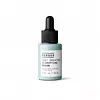What's inside
What's inside
 Key Ingredients
Key Ingredients

 Benefits
Benefits

 Concerns
Concerns

 Ingredients Side-by-side
Ingredients Side-by-side

Water
Skin ConditioningGlycerin
HumectantNiacinamide
SmoothingSalix Nigra Bark Extract
Skin ProtectingZinc Gluconate
Skin ConditioningSodium Hyaluronate
HumectantSalicylic Acid
MaskingAesculus Hippocastanum Seed Extract
Skin ConditioningCeramide AP
Skin Conditioning1,2-Hexanediol
Skin ConditioningButylene Glycol
HumectantPhenoxyethanol
PreservativePEG-40 Hydrogenated Castor Oil
EmulsifyingHydroxyethylcellulose
Emulsion StabilisingYeast Extract
Skin ConditioningGlyceryl Acrylate/Acrylic Acid Copolymer
HumectantTrisodium Ethylenediamine Disuccinate
Ammonium Glycyrrhizate
MaskingBiotin
AntiseborrhoeicPanthenol
Skin ConditioningPropylene Glycol
HumectantCaffeine
Skin ConditioningWater, Glycerin, Niacinamide, Salix Nigra Bark Extract, Zinc Gluconate, Sodium Hyaluronate, Salicylic Acid, Aesculus Hippocastanum Seed Extract, Ceramide AP, 1,2-Hexanediol, Butylene Glycol, Phenoxyethanol, PEG-40 Hydrogenated Castor Oil, Hydroxyethylcellulose, Yeast Extract, Glyceryl Acrylate/Acrylic Acid Copolymer, Trisodium Ethylenediamine Disuccinate, Ammonium Glycyrrhizate, Biotin, Panthenol, Propylene Glycol, Caffeine
Salicylic Acid 0.75%
MaskingVitis Vinifera
MaskingPyrus Malus Juice
Skin ConditioningAloe Barbadensis Leaf Juice
Skin ConditioningCitrus Limon Juice
Skin ConditioningGlycerin
HumectantSclerotium Gum
Emulsion StabilisingAlgin
MaskingSalix Alba Bark Extract
AstringentAllantoin
Skin ConditioningDecyl Glucoside
CleansingPanthenol
Skin ConditioningMagnesium Ascorbyl Phosphate
AntioxidantTocopherol
AntioxidantSalvia Officinalis Leaf Oil
Ubiquinone
AntioxidantSaccharum Officinarum Extract
MoisturisingCamellia Sinensis Extract
AntioxidantCamellia Sinensis Leaf Extract
AntimicrobialLavandula Angustifolia Extract
Skin ConditioningChamomilla Recutita Extract
Skin ConditioningMelissa Officinalis Leaf Extract
Skin ConditioningAlgae Extract
EmollientSodium Benzoate
MaskingPotassium Sorbate
PreservativeCitric Acid
BufferingLavandula Angustifolia Oil
MaskingOlibanum
MaskingSalicylic Acid 0.75%, Vitis Vinifera, Pyrus Malus Juice, Aloe Barbadensis Leaf Juice, Citrus Limon Juice, Glycerin, Sclerotium Gum, Algin, Salix Alba Bark Extract, Allantoin, Decyl Glucoside, Panthenol, Magnesium Ascorbyl Phosphate, Tocopherol, Salvia Officinalis Leaf Oil, Ubiquinone, Saccharum Officinarum Extract, Camellia Sinensis Extract, Camellia Sinensis Leaf Extract, Lavandula Angustifolia Extract, Chamomilla Recutita Extract, Melissa Officinalis Leaf Extract, Algae Extract, Sodium Benzoate, Potassium Sorbate, Citric Acid, Lavandula Angustifolia Oil, Olibanum
 Reviews
Reviews

Ingredients Explained
These ingredients are found in both products.
Ingredients higher up in an ingredient list are typically present in a larger amount.
Glycerin is already naturally found in your skin. It helps moisturize and protect your skin.
A study from 2016 found glycerin to be more effective as a humectant than AHAs and hyaluronic acid.
As a humectant, it helps the skin stay hydrated by pulling moisture to your skin. The low molecular weight of glycerin allows it to pull moisture into the deeper layers of your skin.
Hydrated skin improves your skin barrier; Your skin barrier helps protect against irritants and bacteria.
Glycerin has also been found to have antimicrobial and antiviral properties. Due to these properties, glycerin is often used in wound and burn treatments.
In cosmetics, glycerin is usually derived from plants such as soybean or palm. However, it can also be sourced from animals, such as tallow or animal fat.
This ingredient is organic, colorless, odorless, and non-toxic.
Glycerin is the name for this ingredient in American English. British English uses Glycerol/Glycerine.
Learn more about GlycerinPanthenol is a common ingredient that helps hydrate and soothe the skin. It is found naturally in our skin and hair.
There are two forms of panthenol: D and L.
D-panthenol is also known as dexpanthenol. Most cosmetics use dexpanthenol or a mixture of D and L-panthenol.
Panthenol is famous due to its ability to go deeper into the skin's layers. Using this ingredient has numerous pros (and no cons):
Like hyaluronic acid, panthenol is a humectant. Humectants are able to bind and hold large amounts of water to keep skin hydrated.
This ingredient works well for wound healing. It works by increasing tissue in the wound and helps close open wounds.
Once oxidized, panthenol converts to pantothenic acid. Panthothenic acid is found in all living cells.
This ingredient is also referred to as pro-vitamin B5.
Learn more about PanthenolSalicylic Acid (also known as beta hydroxy acid or BHA) is a well-known ingredient for treating skin that struggles with acne and clogged pores. It exfoliates both the skin's surface and deep within the pores to help clear out buildup, control oil, and reduce inflammation.
Unlike AHAs (alpha hydroxy acids), salicylic acid is oil-soluble. This allows it to penetrate into pores which makes it especially effective for treating blackheads and preventing future breakouts.
Salicylic acid is also known for its soothing properties. It has a similar structure to aspirin and can calm inflamed or irritated skin, making it a good option for acne-prone skin that is also sensitive.
Concentrations of 0.5-2% are recognized by the U.S. FDA as an over-the-counter topical acne product.
It can cause irritation and/or dryness if one's skin already has a compromised moisture barrier, so it's best to focus on repairing that before introducing this ingredient into your routine.
While salicylic acid does not increase sun sensitivity, it’s still important to wear sunscreen daily to protect your skin.
If you are looking for the ingredient called BHA or Butylated Hydroxyanisole, click here.
Learn more about Salicylic Acid